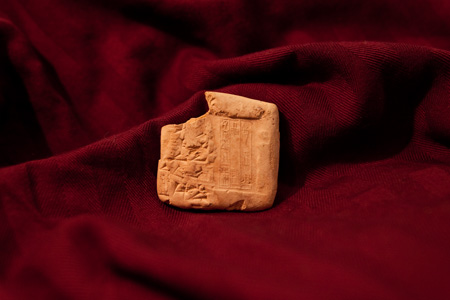Contact: hornmuseum@andrews.edu
Website: http://www.andrews.edu/archaeology
Phone: 269-471-3273
The Horn Archaeological Museum recently received a donation of ancient artifacts from Dick Rentfro, a pastor from the state of Washington. The collection includes an arrowhead, an Egyptian coin, a Samarian pot, and a mammoth tooth—and a clay cuneiform tablet from around B.C. 2039.
The one-inch tablet from the Third Dynasty of Ur is a receipt of a goat, signed by the scribe Lukalla. The transaction occurred in the tenth month (the day is illegible) of the 7th year of Amar-Sin’s reign, in the province of Umma. The tablet was translated by the curators at the Babylonian Collection of Yale University, and reads: “One dead goat, received from Lugal-mashtaba, sealed by Lukalla. The month of the feast of Shulgi, the year Huhnuri was destroyed.”
Rentfro was one of the participants in the 1957 Holy Land tour sponsored by Siegfried Horn. He attended as part of some Advanced Studies classes he was taking at Potomac University, which was shortly to combine with Emmanuel Missionary College and become Andrews University. He and 40 others spent two months visiting sites such as Petra, Nineveh and Babylon. The experience made such a large impact on Rentfro that when he heard of the Horn Museum, he knew the gift “had to go there.”
 |
The Egyptian coin dates from B.C. 221-204, and quite possibly was in circulation during the lifetime of Jesus. The Samarian pot dates to the time of Christ and the arrowhead dates from B.C. 1500. The arrowhead was found near the city of Mamaria. The mammoth tooth was found in Oregon by a friend of Rentfro, and the Horn Museum plans to donate the tooth to the Andrews University Museum of Natural History, located in the Science Complex.
The Horn Museum houses one of the largest cuneiform collections in the country. The curators of the Horn have teamed up with the Cuneiform Digital Library Initiative (CDLI). A collaborative effort between Assyriologists, museum curators and archaeologists, the project’s goal is to make the images and content of large cuneiform collections available through the Internet. CDLI has currently catalogued over 246,000 documents, dating from the birth of writing, ca. B.C. 3350 until just before the time of Christ. For more information about the Horn and the CDLI collection, visit www.cdli.ucla.edu.
-Written by Samantha Snively, student news writer, Office of Integrated Marketing & Communication